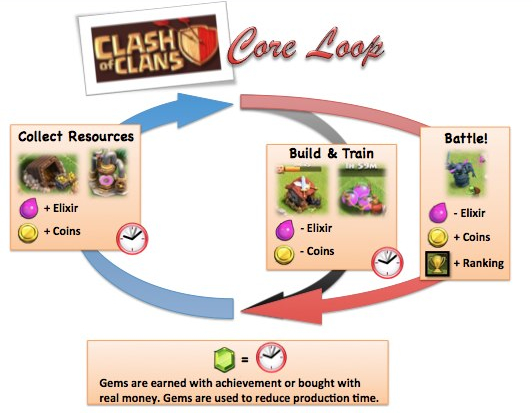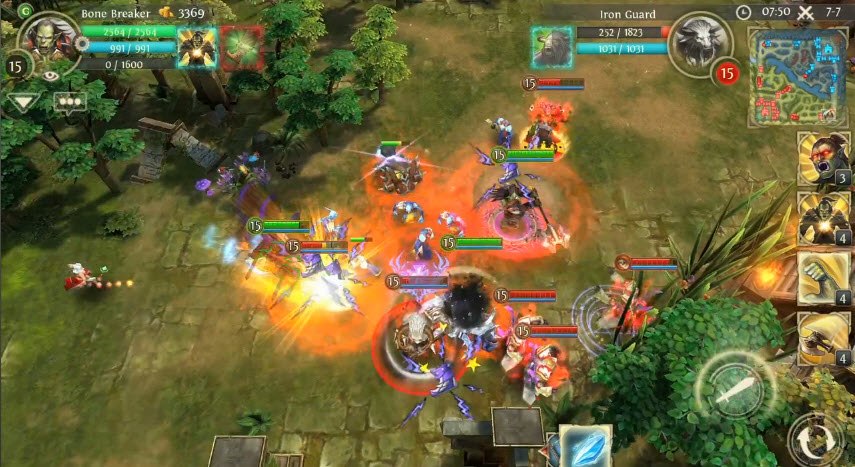· 7 min read
Mid-Core Success Part 1: Core Loops
Michail Katkoff
Product Manager at Supercell
Editor’s note: Make sure to check out the other instalments in the series:
- Part 2: Improving Player Retention
- Part 3: Embracing Social Gaming
- Part 4: Maximizing In-Game Monetization
Why Mid-Core?
I’m going to be honest with you. I didn’t want to write about “mid-core”. I’m not a fan of portfolio thinking and that is what mid-core essentially stands for. Casual games designed for adult males with a gaming background, but who simply don’t have time to play now that they are older. Games designed for adult males, who have a steady income, a credit card and the desire to compete in a virtual world.
But what can I do. You demand a post on mid core and I deliver. So here it goes. Instead of doing one very long post, I’m going to break this down into 4 posts going through core loops, retention, social and finally monetization aspects.
This first write-up is about mid-core core loops. It concentrates not only on the loop structure but also on what the loops aim to achieve. I’ll also talk about the cardinal sin of most mid core titles and how to avoid them with proper core loop design. Finally I’ll go into the invisible, yet essential part of any mid-core game, the metagame.
Mid-Core Core Loops
When looking at core loops of successful mid-core titles, they all have three key distinctive elements. First one is the dual loop, where each core loop consists of two separate session loops. A second element is the controlled length of a median session, which actually results from the dual loop. Third element is the metagame, which isn’t visible in the core loop, but is still a key part of any mid-core game’s success.
1. Dual Loop
Having a core loop consisting of two loops enables players to either stop their session after the first loop or continue playing through both of the loops and thus extend and deepen their session. Enabling and rewarding short sessions encourages players to play the game on the go, increasing overall engagement and setting players up for the metagame, which I will dive into later in this post.

In all its simplicity, Clash of Clans’ core loop consists of three different actions: resource collection, building & training and battling. All pieces of the loop, except building, encourage players to do multiple sessions per day. A very quick 30s session might be just about collecting resources, while full sessions with attack and setting up new troops to be trained takes less than 5 minutes.
In CoC, resource collection is something players can do at any time due to automated farming mechanics, where resource production buildings can always be collected. In other words, any time a player opens up the app, there are resources to be collected (even if the player has been raided). Quick visits to the game are thus encouraged positively via the core loop , while a long time away from the game is mildly punished with the looting of unharvested resources.
Resource collection and the threat to be looted are the main drivers for short sessions for low-level users, while high-level users are driven back to the game with social features, which I’ll cover in the metagame portion of this post.
Building new buildings is fast in the beginning but exponentially slows down as the game progresses, creating powerful mid and long term goals for the players. To keep the timers in balance, the troop training is a lot faster, forcing players to wait often less than an hour until a full army is again ready for battle.

Card battlers, and especially my favorite one MWoH, are another example of successful mid core games with double loops. Where CoC’s core loop was tied to PvP, MWoH’s core loop is separated into single and multiplayer loops with distinctive energies for each of the loop.
The single player loop is all about grinding and earning cards. Players can complete a level in well under a minute, earning several cards in the process. Same goes with the PvP loop, which is even faster, as it’s only one battle. These two loops, fuelled by energy mechanics, encourage players to come back to the game multiple times per day.
Longer sessions are created as a result of several smaller sessions. You see, when every session rewards player with multiple cards, at some point of the day the player will end up spending a considerable amount of time going through the gained cards, entering the metagame of leveling up and evolutions.
2. Session Length
Excessively long sessions lengths are the cardinal sin a mid-core game. As developers, we just tend to get carried away with these games because they are the type of games that we love to play.

Don’t get me wrong, there’s nothing bad in a long session. In fact, long play sessions are great indicators of players enjoying the game. But if every session demands several minutes of uninterrupted attention, it tends to result in retention problems. If players don’t play the game several times during short brakes around a day, the game won’t turn into a habit. And it’s when you go from a fun game to a habit that you start seeing those incredible 6 months retention numbers.
3. The Metagame
In my opinion, the most distinctive element of any mid-core game is the metagame. The metagame is the invisible part of the core loop that you have to experience. The part where players don’t actually earn or consume any resources, but simply stay engaged in the game with a simple goal to optimize their progress.

As we talked before, a short median session length is ideal to keep players engaged during the day. But in order to create that deep gameplay which defines and differentiates mid-core games, a game has to be able to keep players engaged in long sessions as well. Enable sessions where players can go deep into the game strategy, break their goals into sub-goals and most importantly, allow them to interact with other players.
It’s All About Balance
It should be no surprise that a successful core loop in a mid-core title should follow pretty much the same lines as any F2P game’s core loop. Short, accessible and rewarding sessions should be the main goal. Instead of forcing the players to do long sessions, ypu should lure them to spend more time inside the game through the metagame. Hiding the complexity and letting the players to get curious and explore those themselves makes the game more accessible and is the key for having a successful metagame. Oh, and a gentle slap on player’s wrist for not logging in in a while is just fine.
And finally, don’t try to segment your audience. You’d be surprised who actually plays these games we like to call mid-core.
Editor’s note: make sure to check out the next article in this series: Improving Player Retention